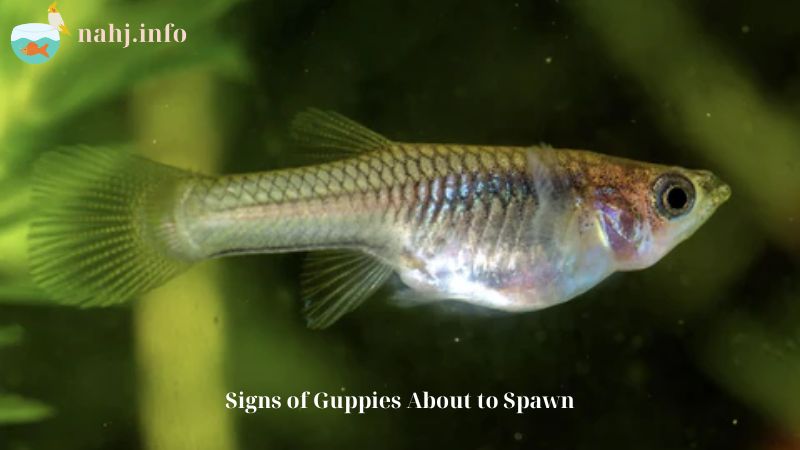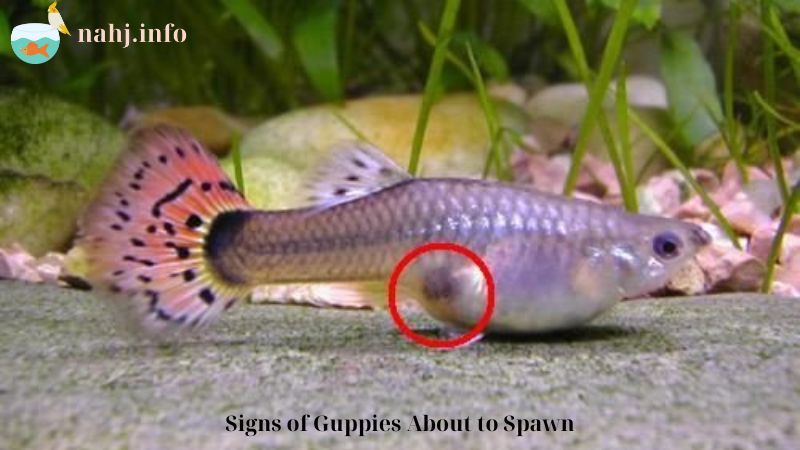Guppies, also known as guppy fish (scientific name Poecilia reticulata), are one of the most popular and easy-to-care-for aquarium fish. With their colorful beauty and gentle temperament, guppies are not only attractive to beginners but also a favorite choice of many veteran aquarium keepers. One of the important aspects of keeping guppies is knowing when they are about to spawn so that you can prepare the environment and provide them with the proper care. In this article, nahj.info will explore in detail the Signs of Guppies About to Spawn, how to care for pregnant fish, and what to keep in mind to ensure the health of both mother and baby fish.
1. Introduction to Guppies
a. Biological Characteristics
Guppies are freshwater fish belonging to the Poeciliidae family and are native to tropical Central and South America. This fish is known for its brilliant beauty and diverse colors. Guppies can live for about 1-3 years, with a size of 4-6 cm when mature. They have a high reproductive capacity and can easily adapt to many different breeding environments.
b. Reproduction Mode
Guppies are live-bearing fish, meaning they give birth to fully developed fry without laying eggs. A female guppy can reproduce every month and each litter can contain 20-60 fry, depending on the health and age of the mother fish. Knowing when a guppies are about to give birth is very important in order to prepare the environment and take the best care of the mother fish.
2. Signs of Guppies About to Spawn

a. Changes in Color
One of the first Signs of Guppies About to Spawn that a guppies are about to give birth is a change in color. The mother fish may become brighter or have signs of color changes on the belly and fins. Often, you will see the mother fish’s color become darker or have strange color markings appear on her body.
b. The Mother Fish’s Belly Grows
When the guppies are about to give birth, the mother fish’s belly will gradually become larger and appear to be stretched. The mother fish’s belly will often become round and bulging, especially near the pelvic fins. This is a clear sign that the mother fish is pregnant and preparing to give birth.
c. The Mother Fish’s Tail Has a “Bullet Head” Sign
Another sign is a change in the shape of the mother fish’s tail. The mother fish’s tail will have a “bullet head” shape and may appear darker than the rest of her body. This is a sign that the mother fish is preparing to give birth and that her reproductive organs are active.
d. Increased Birthing Behavior
When the guppies are about to give birth, you will see the mother fish tend to look for a quiet and safe place in the tank. The mother fish may move around more and seek out areas such as plants, rocks, or corners of the tank to create privacy for giving birth. This is when the mother fish feels the need to prepare the breeding environment.
e. Behavioral Changes
The mother fish’s behavior may also change when she is about to give birth. She may become more aggressive or tend to hide more. This is a sign that she is feeling stressed and needs a quiet environment to breed.
3. Preparing the Breeding Environment

a. Providing Hiding Places
In order for guppies to breed successfully, you need to provide hiding places for the mother fish in the tank. Plants, rocks, and other decorative materials help create safe areas for the mother fish to give birth. Providing this environment helps reduce stress for the mother fish and increase the survival rate of the fry.
b. Regular Water Changes
Maintaining the water quality in the tank is very important when the mother fish is about to give birth. Regularly change the water and check water parameters such as pH, ammonia, nitrite and nitrate to ensure the mother fish’s living environment is always clean and stable. Changing the water will help reduce the risk of disease for both the mother fish and the baby fish.
c. Adjust the Water Temperature
Guppies prefer warm water with an ideal temperature of 24-28°C. During the time the mother fish is about to give birth, maintain a stable water temperature within this range to help the mother fish feel comfortable and support the breeding process. Water temperatures that are too low or too high can cause stress for the mother fish and affect the health of the baby fish.
4. Care for the Mother Fish and Baby Fish
a. Create Breeding Conditions
Once the mother fish has given birth, it is very important to care for the mother fish and the baby fish. Make sure to provide a quiet and safe living environment for the baby fish to grow healthily. Provide high-quality food for the mother fish to help restore health after the breeding process.
b. Raising Baby Fish
Newborn baby fish are very small and need special care. Provide the baby fish with small foods such as artemia nauplii or specialized fish meal to help them grow. Make sure the water environment is always clean and free of elements that are dangerous to the baby fish.
c. Health Monitoring
Monitor the health of the mother and baby fish daily to detect early signs of disease. The mother and baby fish should be checked regularly to ensure that they are free of common diseases such as fungus, fin rot or digestive problems.
5. Common Diseases and Prevention

a. Fungal Diseases
Fungal diseases can appear on the body of mother and baby fish in the form of white spots. To prevent fungal diseases, maintain a clean water environment and check the water quality regularly. If you detect signs of fungal diseases, you can use antifungal drugs and increase the water temperature to support the treatment.
b. Fin Rot
Fin rot causes the fish’s fins to rot and lose color. To prevent this disease, make sure the water environment is always clean and provide a balanced diet for the mother fish. If the fish has fin rot, change the water regularly and use fin rot drugs.
c. Scale Rot
Scale rot causes the fish’s scales to fall off and the fish’s body to become ulcerated. The main cause is water pollution or trauma. To prevent this disease, maintain good water quality and provide a nutritious diet. If the fish has scale rot, change the water and treat with specialized medicine.

